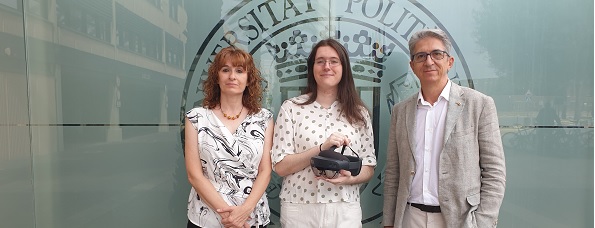Universitat de València (Spain) Mixed reality app

A team from the Universitat Politècnica de València (UPV), belonging to the ai2 Institute, and the Francesc de Borja University Hospital in Gandia has developed a mixed reality application that helps the surgeon to improve the precision of the intervention of the hip prosthesis implant.
The application has been designed to be used with the HoloLens 2 mixed reality glasses, through which the surgeon, during the intervention in the operating room, visualizes a virtual guide that helps him calculate the exact place where to place the prosthesis.
Professor Damián Mifsut Miedes, Head of the Orthopaedic Surgery and Traumatology Service at the Francesc de Borja Hospital, explains that “a fundamental step in the implantation of a hip prosthesis is the milling of the acetabulum or cavity of the pelvis on which the prosthesis will be supported and the subsequent impaction of the acetabular component. This cavity has a certain inclination and anteversion with respect to the whole of the pelvis and, therefore, when we mill the bone to be able to place the prosthesis later, we have to do it following these angles. To date, this calculation is done in a very artisanal way and based on the experience of each surgeon. Metal rods are used together with the surgical instruments, which guide only in the final impaction of the definitive implant”, specifies Mifsut.
The application will allow the surgeon to choose the necessary degrees of inclination and anteversion by placing the HoloLens 2 glasses, visually, and with the possibility of making a fine adjustment using the virtual menus. From there, the application draws a virtual axis that remains constant and visible to the surgeon throughout the intervention through the HoloLens, so that when the doctor is ready to mill the acetabulum of the pelvis, he always has this virtual guide in mind.
On the other hand, once the milling is finished, when impacting the prosthesis in the bone cavity, the implant can also be placed following the same visible axis, thus ensuring that it will have the correct inclination and anteversion.
The application has been developed by the group of the researcher of the ai2 Institute and professor of the UPV, M. Carmen Juan, with the participation of the student of the Master’s Degree in Artificial Intelligence, Shape Recognition and Digital Image (ARFID), Cora Hidalgo Aliena. These developments are part of its TFM.
Better prosthesis life
The application allows surgeons with less experience to have a more surgical instrument of guidance in the operating room, totally reliable and efficient. But, in addition, according to Mifsut, “the greater precision in the intervention avoids dislocations, loosening and future wear of the prosthesis, being better placed”. Another advantage is that, being a virtual system, it does not interfere with the sterility of the surgical field, since there is no physical contact with the patient.
Mª Carmen Juan, with a long career in mixed reality applications for health, comments that “the application, in addition to helping in interventions, could be used for learning and prosthesis manufacturers could be interested in it, since it is a system that can be adapted to the implantation of any model of hip prosthesis. The HoloLens 2 is an ideal device for this environment, as the surgeon can see through the glasses the real world and the overlapping elements that will help him to have more information during the intervention. The fact that the glasses fit your field of vision means you don’t need to look up to look at a screen. You can interact on-site with app menus using hand gestures. Also, it’s very easy to lift the viewfinder so that the surgeon gets out of mixed reality and sees only the real world again.”
Study in patients
So far, validations have been carried out on pelvic phantoms and cadavers. “We are currently waiting for the approval of the Ethics Committee of the Francesc de Borja Hospital to start a comparative study in patients. In one group the classic angulation measurement guides will be used and in another the mixed reality solution will also be added.”
In addition, the registration of code of the development, pioneer in the market, has been carried out.
